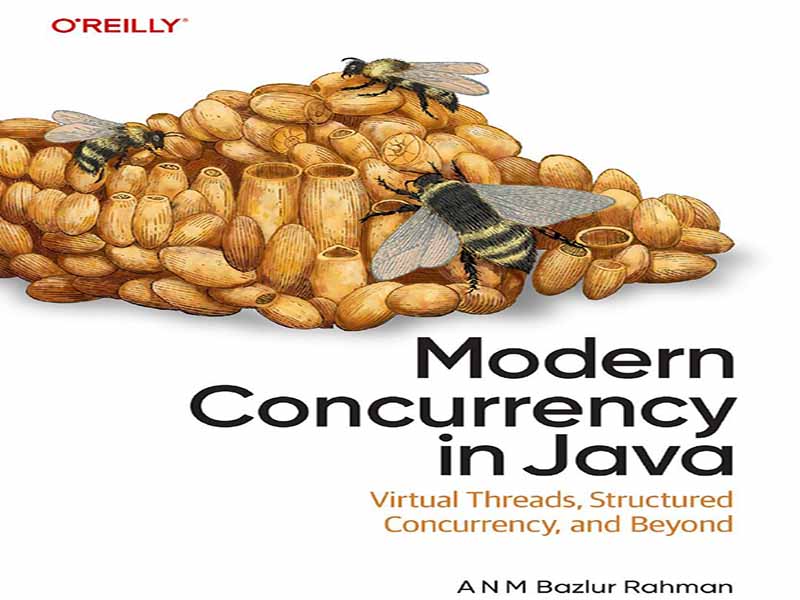- عنوان کتاب: Modern Concurrency in Java
- نویسنده: A N M Bazlur Rahman
- حوزه: برنامهنویسی جاوا
- سال انتشار: 2025
- تعداد صفحه: 463
- زبان اصلی: انگلیسی
- نوع فایل: pdf
- حجم فایل: 4.51 مگابایت
همزمانی مدتهاست که یکی از چالشبرانگیزترین جنبههای توسعه جاوا بوده است. این زبان به طور مداوم برای برآورده کردن نیازهای توسعه نرمافزار مدرن تکامل یافته است، در حالی که تعهد قوی به سازگاری با نسخههای قبلی را حفظ کرده است. در میان تمام پیشرفتهایی که جاوا در طول سالها معرفی کرده است، معرفی نخهای مجازی توسط پروژه Loom نشاندهنده یک تغییر اساسی در دنیای همزمانی است. همزمانی ذاتاً چالشبرانگیز است و این دشواری با افزایش تقاضا برای عملکرد، تنها افزایش یافته است. حتی برای توسعهدهندگان باتجربه، مدیریت مؤثر آن همچنان یک کار پیچیده است. امروزه، برنامههای مدرن در درجه اول مبتنی بر ورودی/خروجی هستند، زیرا با سیستمهای متعدد دیگری، به ویژه در معماری میکروسرویسها که بر توسعه نرمافزارهای اخیر تسلط دارد، تعامل دارند تا نیازهای رو به رشد مقیاسپذیری را برآورده کنند. عملیات ورودی/خروجی اغلب زمان قابل توجهی طول میکشد. وقتی یک نخ یک فراخوانی ورودی/خروجی انجام میدهد، معمولاً باید منتظر تکمیل عملیات بماند، که رویکرد سنتی بوده است. در حالی که سیستمهای عامل مدرن میتوانند میلیونها سوکت باز را مدیریت کنند، تعداد نخهای موجود همچنان محدود است. در نتیجه، برآورده کردن تقاضای رو به رشد برای توان عملیاتی بالاتر با نخهای سنتی به طور فزایندهای پیچیده شده است. در پاسخ به این محدودیت، تکنیکها و مدلهای همزمانی جایگزین مختلفی ابداع شدهاند، اما هر کدام با مجموعهای از بدهبستانهای خاص خود همراه هستند. رشتههای مجازی با بهرهگیری از رشتههای سبک و کاربر-محور که میتوانند در تعداد کمتری از رشتههای هسته مالتی پلکس شوند، یک راهحل امیدوارکننده را ارائه میدهند. این رویکرد امکان استفاده کارآمدتر از منابع سیستم را فراهم میکند. این روش مقیاسپذیری را افزایش میدهد و پیشرفت قابل توجهی در دنیای همزمانی ایجاد میکند. وقتی برای اولین بار با رشتههای مجازی مواجه شدم، فوراً مجذوب آنها شدم. آنها مانند یک پیشرفت مدتها مورد انتظار بودند که میتوانستند اساساً نحوه نوشتن برنامههای همزمان در JVM را تغییر دهند و یک راهحل ساده و زیبا ارائه دهند، در حالی که جاوا قبلاً فاقد آن بود. من شروع به آزمایش با رشتههای مجازی کردم، یافتههای خود را در وبلاگم مستندسازی کردم و در کنفرانسها صحبت کردم. واکنش مشتاقانه جامعه توسعهدهندگان مجدداً تأیید کرد که رشتههای مجازی نه تنها یک پیشرفت دیگر، بلکه یک تغییر اساسی در رویکرد به همزمانی هستند. همانطور که به کاوش ادامه میدادم، منابع زیادی را کشف کردم که پیرامون رشتههای مجازی در حال ظهور بودند – مستندات رسمی، پستهای وبلاگ آموزنده، مخازن GitHub با مثالهای دنیای واقعی و جلسات عالی کنفرانس. اگرچه این منابع به صورت جداگانه ارزشمند بودند، اما هر کدام بر جنبههای مختلفی از موضوع تمرکز داشتند. برخی به پیادهسازیهای فنی پرداختند، در حالی که برخی دیگر استراتژیهای مهاجرت و موارد استفاده خاص را مورد بحث قرار دادند. از طریق نوشتن، صحبت کردن و کار عملی مداوم، درک واضحتر و جامعتری از موضوع به دست آوردم. این کاوش، درک جامعی از انگیزههای پشت پروژه Loom، ادغام آن با مدل همزمانی موجود جاوا و پیامدهای آن برای ساخت سیستمهای مقیاسپذیر و قابل نگهداری ارائه داد. احترام من به توانایی جاوا در سازگاری با تغییرات ضمن حفظ سازگاری با عقب، در طول این سفر تنها تشدید شده است. در نهایت، متوجه شدم فرصتی برای تجمیع همه این درک در یک منبع واحد و عملی وجود دارد. این کتاب فقط یک کاوش نظری نیست، بلکه یک راهنمای عملی و عملی است که تمام مفاهیم، مثالها و بهترین شیوههای لازم را در یک منبع واحد و جامع جمعآوری میکند.
Concurrency has long been one of the most challenging aspects of Java development. It has consistently evolved to meet the demands of modern software development while maintaining a strong commitment to backward compatibility. Among all the advancements Java has introduced over the years, Project Loom’s introduction of virtual threads marks a fundamental shift in the world of concurrency. Concurrency is inherently challenging, and this difficulty has only increased with the rise in performance demands. Even for seasoned developers, managing it effectively remains a complex task. Today, modern applications are primarily I/O-driven, as they interact with numerous other systems, especially within the microservices architecture that dominates recent software development to meet the growing demands of scalability. I/O operations often take a significant amount of time. When a thread makes an I/O call, it typically has to wait for the operation to complete, which has been the traditional approach. While modern operating systems can manage millions of open sockets, the number of available threads remains limited. As a result, meeting the growing demand for higher throughput with traditional threads has become increasingly complex. In response to this limitation, various techniques and alternative concurrency models have been devised, but each comes with its own set of trade-offs. Virtual threads represent a promising solution by leveraging lightweight, user-mode threads that can be multiplexed onto a smaller number of kernel threads. This approach enables more efficient use of system resources. It enhances scalability, marking a notable improvement in the world of concurrency. When I first encountered virtual threads, I was immediately intrigued. They felt like a long-awaited breakthrough that could fundamentally change how we write concurrent programs on the JVM, offering a simple and elegant solution where Java previously lacked one. I began experimenting with virtual threads, documenting my findings on my blog, and speaking at conferences. The enthusiastic response from the developer community reaffirmed that virtual threads were not just another enhancement but a fundamental shift in the approach to concurrency. As I continued to explore, I discovered a wealth of resources emerging around virtual threads—official documentation, insightful blog posts, GitHub repositories with real-world examples, and excellent conference sessions. While these resources were individually valuable, each focused on different aspects of the topic. Some addressed technical implementations, while others discussed migration strategies and specific use cases. Through continuous writing, speaking, and hands-on work, I gained a clearer and more comprehensive understanding of the subject. This exploration provided a comprehensive understanding of the motivations behind project Loom, its integration with Java’s existing concurrency model, and its implications for building scalable and maintainable systems. My respect for Java’s ability to adapt to change while maintaining backward compatibility has only intensified throughout this journey. Eventually, I realized there was an opportunity to consolidate all this understanding into a single, practical resource. This book is not just a theoretical exploration but a practical, hands-on guide that gathers all the necessary concepts, examples, and best practices into a single, comprehensive resource.
این کتاب را میتوانید از لینک زیر بصورت رایگان دانلود کنید:
Download: Modern Concurrency in Java




































نظرات کاربران